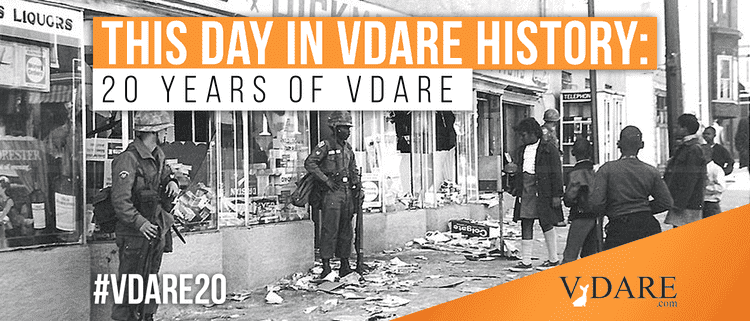


By Steve Sailer
05/31/2020
From the Roosevelt Institute, a couple of leftists explain the inexplicable:
Rioting Mainly for Fun and Profit: The Neoconservative Origins of Our Police Problem
BY MIKE KONCZAL / FRIDAY, 15 AUGUST 2014 / PUBLISHED IN BLOG, NEWS, RORTYBOMBBefore it was anything else, the neoconservative movement was a theory of the urban crisis. As a reaction to the urban riots of the 1960s, it put an ideological and social-scientific veneer on a doctrine that called for overwhelming force against minor infractions — a doctrine that is still with us today, as people are killed for walking down the street in Ferguson and allegedly selling single cigarettes in New York. But neoconservatives also sought, rather successfully, to position liberalism itself as the cause of the urban crisis, solvable only through the reassertion of order through the market and the police.
Edward Banfield was one of the first neoconservative thinkers who started writing in the 1960s and ’70s and was a prominent figure in the movement, though he isn’t remembered as well as his close friends Milton Friedman or Leo Strauss, or his star student James Q. Wilson. Banfield contributed to the beginning of neoconservative urban crisis thinking, the Summer 1969 “Focus on New York” issue of The Public Interest, which began to formalize neoconservatives’ framing of the urban crisis as the result of not just the Great Society in particular but the liberal project as a whole.
In his major book The Unheavenly City (pdf here), Banfield set the tone for much of what would come in the movement. Commentary described the book as “a political scientist’s version of Milton Friedman’s Capitalism and Freedom” at the time. It sold 100,000 copies, and gathered both extensive news coverage and academic interest.
The Unheavenly City’s most infamous chapter is “Rioting Mainly for Fun and Profit.” Fresh off televised riots in Watts, Detroit, and Newark, Banfield argued that it was “naive to think that efforts to end racial injustice and to eliminate poverty, slums, and unemployment will have an appreciable effect upon the amount of rioting that will be done in the next decade or two.” Absolute living standards had been rising rapidly. For Banfield, this was entirely the result of market and social forces rather than the state, and the poor, with their short time-horizons and desire for immediate gratification, would largely be left behind and always be prone to rioting. Today’s classic, if often implicit, repudiations of poor people’s humanity were clearly expressed here.
Rather than political protests or rebellions, Banfield argued that riots were largely opportunistic displays of violence and theft. He broke down four types of riots: (1) rampages, where young men are simply looking for trouble and act out violently; (2) pillaging, where theft is the main focus, and the riot serves as a solution for a type of collective action problem for thieves; (3) righteous indignation, where people act against an insult against their community; and (4) demonstrations, which are neither spontaneous nor violent but instead designed for a specific political purpose.
Banfield argued that the poor mainly engaged in the first two types of riots. Righteous indignation riots were a feature of the working class, because the “lower-class individual is too alienated to be capable of much indignation.” Demonstrations were largely the focus of the middle and upper classes, as they ran organizations and were able to make coherent claims on the state.
At this point Banfield’s text reads like a list of cranky, armchair reactionary observations about riots. It received considerable blowback at the time. What was innovative, for a neoconservative agenda, was where he put the blame. Young men will be young men, the text seems to suggest. The problem is what enables them to riot.
The initial perpetrators included the media, whose neutral (or even sensationalistic) coverage “recruited rampagers, pillagers, and others to the scene.” They also made the rioting more dangerous by expanding the knowledge base of the rioters. The larger academic community was also at fault since, to Banfield’s ear, “explaining the riots tended to justify them.” Upper-class demonstrators were also responsible for raising expectations of what the poor could demand from the state and from society writ large.
But what has anybody learned in the last 50 years? It would be racist to learn from the past.